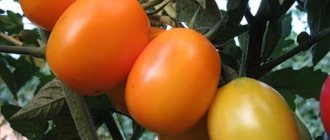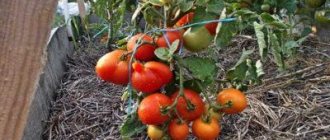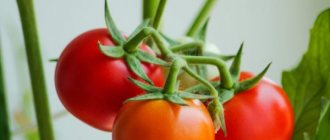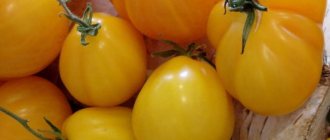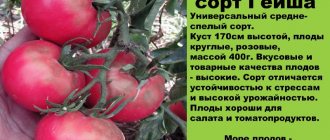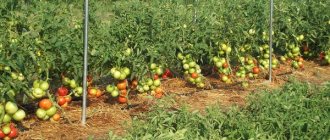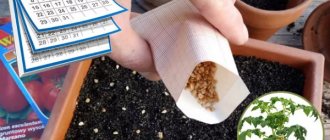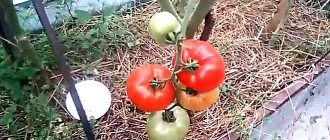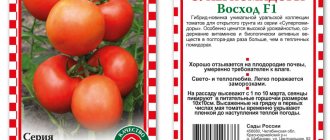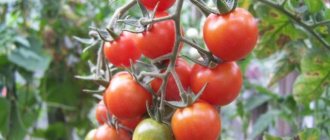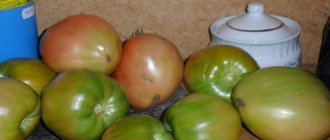Honey Cream tomatoes are known for their universal use, compactness of bushes and ease of care. This is one of the most successful tomato varieties both for sale and for growing in the garden.
| Height | Landing location | Ripening time | Fruit color | Fruit size | Origin | Fruit shape |
| short | Greenhouse, Open ground | Early ripening | Reds | Average | Variety | Plum-shaped or oval |
Description of the variety
“Honey Cream” is an early ripening variety. Blazing maturity occurs 80 days after planting, and full technical maturity occurs 105-110 after germination. “Self-cultivating” bushes stop growing at around 60 cm. The foliage is moderate.
Fruit
The name of the variety well characterizes the main features of its fruits: they have a plum-shaped shape without a spout, and their pulp has a magnificent sweet taste. The color of mature skin is traditional bright red. The average weight of one tomato is 60-70 grams.
New varieties of tomatoes:
Other important fruit qualities:
- Strict proportionality - all fruits in the cluster are approximately the same size;
- Not high dry matter content;
- Small number of seeds;
- Fragrant pulp.
Features of the “Honey Cream” fruits
Tomatoes are truly like honey cream, characterized by a neat appearance, smoothness and strength. When tomatoes are ripe, they are a rich red color. The tomatoes weigh a little over half a kilo. The fruits have a good balanced taste and are not prone to cracking.
Vegetables have an average level of dry matter content and a small number of chambers.
This variety of tomatoes is optimal for pickling, canning whole fruits, just like Cherry, and for creating fresh salads for the summer season. They seem to have a honey flavor. Tomatoes tolerate transportation well and can be stored for a long time. And the yield per square meter usually gives tomato owners up to five kilograms of fragrant fruit.
See also
Characteristics and description of the tomato variety King of the Market, its yieldRead
“Honey Cream” has another undeniable advantage - the absence of a reaction to almost all known diseases, including verticillium and fusarium. Thanks to such quality as early ripening, the crop does not suffer from late blight. And to protect vegetables from harmful insects, there are insecticidal preparations. In order to grow tomatoes both for home use and for the desired sale, they need to be provided with proper care, which will be discussed below.
Growing tomatoes
This variety is suitable for cultivation in open ground, in a greenhouse and even on a balcony. Growing occurs in the traditional way - through seedlings.
How to prepare seeds?
Before planting, seeds must undergo complete pre-sowing treatment. This is done in order to increase germination, accelerate the growing season and strengthen the immunity of future plants. The step-by-step processing looks like this :
- Visual inspection. Pay attention to the uniform color, absence of signs of damage, mold and deformation;
- Warming up. Selected seeds are collected in a rag bag and placed on a radiator or stove rack, where they lie for 5-7 days. A quick option is three-hour heating in the oven at 60*C;
- Disinfection. Seed material is soaked in a solution of potassium permanganate for 1-2 hours;
- Stimulation. Treatment with growth stimulants “Epin-Extra” or “Sodium Humate”;
- Soak. A day before planting, the seeds are left in melt water at room temperature.
Important tips for growing seedlings
It is well known that, depending on the proper cultivation of tomato seedlings, the yield of a particular crop, as well as the quality content of its fruits, will be individual. Moreover, you need to start with choosing seeds. The guideline will be the varietal description, harvest time, size and height inherent in the tomato bush, and the level of purity during selection. When deciding to start growing tomatoes and growing seedlings. It is recommended to follow certain rules:
- Visual inspection of purchased seeds is carried out to identify possible voids and deformations in them.
- Upon completion of the selection of the most complete material, the latter is immersed in a solution with salt for some time and all the seeds that floated to the surface are eliminated.
- In order to disinfect the seeds, they are placed in a warm solution of potassium permanganate or hydrogen peroxide for ten minutes or a quarter of an hour.
- To carry out some hardening of the seed material, it is placed in the lower part of the refrigerator for one or two days.
- To make seeds germinate faster, you can use a special method - germination using the surface of a damp fabric material.
See also
Description of the Belfort tomato variety, features of cultivation and careRead
After following all the useful tips, the tomato seeds fall into a pre-arranged and disinfected nutrient soil, which is important for seedling boxes with holes for drainage. Again, remember that sowing is carried out 60 days or a little less before the day when the “Honey Cream” finds its permanent location.
Sowing seed material
A thin layer of expanded clay or charcoal is poured onto the bottom of the planting container, then the base soil. The soil for seedlings should be loose, nutritious and neutral (pH level - 6.0-7.0). The seeds are deepened by 1 cm, watered with warm water and covered with polyethylene until seedlings emerge to create a greenhouse effect of up to 30*C. After the first sprouts “peck”, the film is removed and cultivation continues at a temperature of 22-24*C and air humidity of 30-60%.
When the first leaves appear, the plants are planted in individual containers. Usually they use 400 ml plastic glasses, but it is better to take peat or paper pots that can be transplanted into the garden bed along with the plants in them.
Rules for planting seedlings
Seedlings are planted in a permanent place at the age of 50-60 days. By this time, the soil in the garden bed should be warmed up to 10*C. A week before planting, seedlings begin to harden in the open air with a daytime temperature of 15*C and a night temperature of 12*C.
Recommended planting pattern:
- The interval between bushes is 40 cm;
- Row spacing – 60 cm;
- The maximum planting density is 7-9 plants per 1 sq.m.
REFERENCE : The optimal substrate for seedlings is a mixture of garden turf, peat and sand in a ratio of 2:2:1.
The bushes are placed in the planting hole so that the height of the first leaf is 4-5 cm above ground level. A “nutrient cushion” of a mixture of humus, ash and peat is placed under each plant.
The best varieties of cream tomatoes for greenhouses
Also check out these articles
- Angora rabbit
- Tourist breakfast
- Vidnaya pear variety
- The most common diseases of cucumbers
When you need to get a rich and quick harvest, cream tomatoes are grown in a greenhouse. Greenhouse conditions and a gentle microclimate allow you to accelerate germination and development of plants and fruits. But what types of cream are recommended for greenhouses?
Variety De Barao red
- "De Barao red" is a tall tomato variety, growing up to 2-3 meters in height. It is resistant to a large number of different diseases. Productivity is high. Up to 6 kg of tomatoes are harvested from one plant per season, that is, when planting 2-3 bushes per square meter, you can get 12-18 kg of tomatoes per season! The fruits are red, up to 120 grams, juicy and sweetish. Ideal for canning. Among the disadvantages of the variety, it is worth highlighting: poor combination with other varieties in one area, demanding care.
- “Jury F1” is a greenhouse, early-ripening hybrid, ripening in 85-100 days. Grows up to 1.5 meters. Each cluster produces 10-12 fruits weighing up to 150 grams. The fruits are red, with dense, glossy skin. There is resistance to cracking and some diseases.
- “Palenka F1” is a cream tomato of indeterminate type, medium early, ripens in 105-112 days. Formed into 1 stem, grows up to 185 cm, grown on a trellis. Each bunch contains 4-7 tomatoes, each weighing 120 grams. The fruits are similar in appearance and have a good, presentable appearance. Productivity up to 21.4 kg per square meter.
- “Black Moor” – cream with dwarf tomatoes. The fruits barely reach 45 grams when fully ripe. The variety is mid-season, indeterminate, carpal. The color of the peel is brown. The main disadvantage is susceptibility to disease. Suitable for pickling, freezing, and rarely used in salads.
- “Khokhloma” is a tall variety that requires timely garter. The leaves grow very close to the stem, which is unusual for tomatoes. Formed into 1-2 stems. The variety is productive, 5-7 fruits weighing 150 grams are formed in clusters. Productivity per square meter is up to 10 kg, does not require care, but is easily affected by diseases.
Bush care
The Honey Cream variety requires moderate pinching, otherwise its fruits will not correspond to the nominal size. For normal vegetation, the three strongest stepsons are left, the rest are pinched when they reach a length of 5 cm.
Other rules of agricultural technology:
- Tie the stem to the support. Carried out after the formation of the ovaries;
- Watering with settled water 2-3 times a week;
- Loosening and weeding between waterings;
- Mulching the beds with chopped straw to prevent the soil from drying out;
- Fertilizing with complex fertilizers once every 2 weeks.
Characteristics
Among the main advantages of the variety:
- unpretentiousness;
- versatility, the variety is suitable for both open ground and greenhouses;
- the compact bush does not need staking or pinching;
- high yield - 7-10 kg per sq.m;
- early and friendly ripening of fruits;
- resistance to the main diseases of nightshades (late blight, fusarium, etc.).
The variety also has some minor disadvantages:
- somewhat bland taste;
- requires good watering and fertilizing.
You can compare the yield of this variety with others in the table:
| Variety name | Productivity |
| Large cream | 7-10 kg per square meter |
| Soyuz 8 | 15-19 kg per square meter |
| Balcony miracle | 2 kg per bush |
| Red Dome | 17 kg per square meter |
| Blagovest f1 | 16-17 kg per square meter |
| King of the Early | 12-15 kg per square meter |
| Nikola | 8 kg per square meter |
| Ob domes | 4-6 kg per bush |
| King of Beauty | 5.5-7 kg per bush |
| Pink fleshy | 5-6 kg per square meter |
Diseases and pests
The variety is resistant to diseases:
- Fusarium;
- Verticillium.
Thanks to early ripening, “Honey Cream” rarely suffers from late blight. To reduce morbidity, preventive measures should be followed :
- Maintain a three-year crop rotation in the garden, and change the top layer of soil in the greenhouse every year;
- Avoid the formation of a hard earthen crust, but also do not flood the beds with water;
- Periodically treat plants with Fitosporin.
To combat pests, traditional methods are used: spraying with garlic infusion and dusting with wood ash.
The best varieties of cream tomatoes for open ground
Many domestic gardeners were inspired by Bendrick’s method of growing cream tomatoes. The author has moved away from traditional vegetable farming technology and uses a waterless method of growing tomatoes, which allows the plant to adapt well to the climatic conditions in the area of cultivation and guarantees a stable harvest.
Cream has gained great popularity among gardeners. Most gardeners believe that these tomatoes are worthy of attention. However, there are those who do not like tomatoes. Let's look at some reviews about Slivka tomatoes.
Ivan: “I don’t like this variety. In my opinion, Slivka is a bit dry and requires a lot of attention. I prefer to grow and use classic varieties with large juicy fruits for canning and cooking.”
Tatyana: “I’ve been growing cream for a long time, about 10 years already. This variety was once recommended to me by a consultant at an agricultural store when I decided to diversify my beds with new types of tomatoes. Over the years, I have tried almost all subspecies, I especially liked Royal Cream for its abundant harvest, pleasant aroma and the opportunity to enjoy my favorite tomato at a time when others are just beginning to ripen.
algam, Russia
Bagira66
The best varieties of cream tomatoes for greenhouses
Also check out these articles
- Proper fattening of pigs at home
- What to feed Vietnamese piglets
- Geranium flower
- How to trim onions for long-term storage
When you need to get a rich and quick harvest, cream tomatoes are grown in a greenhouse. Greenhouse conditions and a gentle microclimate allow you to accelerate germination and development of plants and fruits. But what types of cream are recommended for greenhouses?
Variety De Barao red
- "De Barao red" is a tall tomato variety, growing up to 2-3 meters in height. It is resistant to a large number of different diseases. Productivity is high. Up to 6 kg of tomatoes are harvested from one plant per season, that is, when planting 2-3 bushes per square meter, you can get 12-18 kg of tomatoes per season! The fruits are red, up to 120 grams, juicy and sweetish. Ideal for canning. Among the disadvantages of the variety, it is worth highlighting: poor combination with other varieties in one area, demanding care.
- “Jury F1” is a greenhouse, early-ripening hybrid, ripening in 85-100 days. Grows up to 1.5 meters. Each cluster produces 10-12 fruits weighing up to 150 grams. The fruits are red, with dense, glossy skin. There is resistance to cracking and some diseases.
- “Palenka F1” is a cream tomato of indeterminate type, medium early, ripens in 105-112 days. Formed into 1 stem, grows up to 185 cm, grown on a trellis. Each bunch contains 4-7 tomatoes, each weighing 120 grams. The fruits are similar in appearance and have a good, presentable appearance. Productivity up to 21.4 kg per square meter. Variety Black Moor
- “Black Moor” – cream with dwarf tomatoes. The fruits barely reach 45 grams when fully ripe. The variety is mid-season, indeterminate, carpal. The color of the peel is brown. The main disadvantage is susceptibility to disease. Suitable for pickling, freezing, and rarely used in salads.
- “Khokhloma” is a tall variety that requires timely garter. The leaves grow very close to the stem, which is unusual for tomatoes. Formed into 1-2 stems. The variety is productive, 5-7 fruits weighing 150 grams are formed in clusters. Productivity per square meter is up to 10 kg, does not require care, but is easily affected by diseases.
Green tomato Antonovka honey
The Antonovka honey tomato attracts the attention of gardeners with its unusual color. The vegetable belongs to the group of domestically selected tomatoes. The fruits are not intended for mass consumption. They will suit only those gourmets who are looking for a special flavor.
The variety is mid-season. To get a ready-to-eat fruit, you must wait up to 112 days from the moment the seeds are planted. Gardeners who have tested the vegetable agree on the high yield of the variety. The characteristics of the plant give a clearer idea of the new breeding product.
Tomato is determinate. Fruit gartering and removal of stepsons is required. This variety of tomatoes belongs to the universal type, as it can be grown both in open ground and in greenhouse conditions. In the first case, the bush reaches a height of 130 cm. In shelter it grows up to 150 cm. The fruit is characterized by:
- rounded shape;
- light green with small yellow streaks;
- pink flesh.
The advantages of tomato include fairly high yield, good shelf life and safety during transportation.
Among the disadvantages are:
- need for tying;
- instability to late blight;
- the need to remove lower leaves to minimize the risk of fungi.
The description of the variety indicates a peculiarity of the plant - a clearly noticeable honey taste. In this regard, reviews from gardeners are mixed. However, this quality does not prevent the fruits from being used for canning.
Seeds are planted in late March - early April. In this case, the location of the bed is taken into account. If we are talking about an open area, then the seeds are planted later. Before sowing, the soil is fertilized with complex means: organic and mineral substances. Trays must be clean and disinfected with an antiseptic. After the shoots emerge and strengthen, they are thinned out. At the same time, non-viable and diseased plants are discarded.
The growth of tomatoes must be monitored. When several true leaves appear, pick them. At the same time, the 2nd soil fertilization is carried out. 3 plant feeding will be required only on the 60th day after the first shoots appear.
We invite you to read: Feijoa tincture: recipe, beneficial properties and contraindications
As plants develop, it is necessary to systematically loosen the soil. In this way, not only air exchange in the soil is carried out, but the development of various diseases is also prevented.
It is very important to water the tomatoes with warm water. Cold liquid can cause the death of the plant. It's best to defend it. Water vegetables after sunset. It is during this period that the tomato receives the optimal amount of moisture. It is worth remembering that the sun's rays lead not only to the rapid evaporation of water, but also to the burn of the leaves on which it fell.
2 weeks before transplanting seedlings into open ground, they are hardened off. To do this, the seedlings are taken out into the fresh air for 15-20 minutes in the first days and left there for several hours on the 10th day after germination.
Such plants are ready to be planted on the site, since they have developed immunity to changes in temperature and humidity. Before planting seedlings in the soil, the latter is first prepared by applying liquid fertilizers. It is recommended to place no more than 4 bushes per 1 m² of area.
Of no small importance is the prevention of late blight and other diseases, of which there are several dozen. Prevention is carried out even before planting seedlings. Plants are treated with special solutions. Today, no remedy can completely defeat late blight on tomatoes, but stopping it and saving the fruits already on the branches is quite possible.
Great for canning and seaming
| De Barao red Description:
|
| F1 Jury Description:
|
| Palenque F1 Description:
|
| Chio chio san Description:
|
| Moscow cream Description:
|
| Pink cream tomato Description:
|
| Yellow cream Description:
|
| Watercolor Description:
|
| Red cream Description:
|
Variety variations of Cream
Among the early-ripening tomatoes of this variety, the Slivka Moscow tomato is especially popular. The stated description of the variety of such a vegetable tells of its very early fruiting. Harvesting of ripe and tasty fruits begins 100-110 days after sowing the seeds. This variety belongs to determinate plants, suitable for growing in open areas and in greenhouses.
The Moscow Cream tomato has increased productivity and rarely succumbs to various diseases and pests.
The number of leaves on the bushes is not too large, the first inflorescence appears above the seventh leaf, the next ones - every 1-2 leaves. The plant forms brushes. The leaves are bright green, slightly corrugated.
The fruit itself is very compact and neat, weighing 60-100 grams. Each vegetable contains 2-3 chambers. The pulp is elastic, the taste is at a decent level. Such fruits can be successfully preserved and enjoyed in the form of salads.
The Chocolate Cream tomato is an even earlier variety of tomatoes. Harvesting of this variety begins 90-95 days after planting the seeds. A characteristic feature of the variety is its suitability for cultivation only in greenhouses. This is an indeterminate plant.
The fruits are small, reaching no more than 30-50 grams in size. The shape of the vegetables is also similar to plums. The taste is excellent: the vegetables are sweet and firm. Great for salads and canning. A distinctive feature of this variety is the original color of the fruit; ripe vegetables acquire a beautiful red-brown color that resembles a chocolate bar.
Also, the advantage of this variety is the high content in the fruits of such a substance useful for the human body as lycopene. And the resistance to cracking, small size and original color of the fruits give them a very appetizing and respectable appearance in jars for the winter.
Well, for those who prefer larger fruits, the Large Cream tomato is perfect. This is a standard determinate variety of tomatoes. The main advantage of which is excellent yield and excellent taste of the fruit. The fruits weigh 70-100 grams, the color is bright scarlet with an orange tint and a glossy tint. The pulp is also elastic, the fruits are sweet.
The use of the variety is as universal as all its relatives - Cream. Growing is possible both in open soil and in greenhouses. The variety has good productivity. But this variety of tomatoes is very demanding when it comes to watering and fertilizing.
The Pink Cream tomato also received popular love and recognition. These tomatoes differ from other cream tomatoes in their delicate color, they are pink and sweet. In terms of ripening, they are medium early. A plentiful and tasty harvest begins to be harvested 100-110 days after planting the seeds. The fruits are also versatile in use.
Slivka tomatoes, regardless of varietal varieties, are grown from seedlings. In open ground or in a greenhouse, tomatoes require standard approaches to cultivation and care: it is necessary to water the plants in a timely manner, remove weeds, loosen the soil and fertilize. And then you and your loved ones will be able to enjoy delicious fruits, both fresh and canned.
